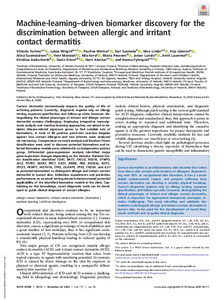Machine-learning-driven biomarker discovery for the discrimination between allergic and irritant contact dermatitis
Fortino, Vittorio; Wisgrill, Lukas; Werner, Paulina; Suomela, Sari; Linder, Nina; Jalonen, Erja; Suomalainen, Alina; Marwah, Veer; Kero, Mia; Pesonen, Maria; Lundin, Johan; Lauerma, Antti; Aalto-Korte, Kristiina; Greco, Dario; Alenius, Harri; Fyhrquist, Nanna (2020)
Fortino, Vittorio
Wisgrill, Lukas
Werner, Paulina
Suomela, Sari
Linder, Nina
Jalonen, Erja
Suomalainen, Alina
Marwah, Veer
Kero, Mia
Pesonen, Maria
Lundin, Johan
Lauerma, Antti
Aalto-Korte, Kristiina
Greco, Dario
Alenius, Harri
Fyhrquist, Nanna
2020
Julkaisun pysyvä osoite on
https://urn.fi/URN:NBN:fi:tuni-202101211573
https://urn.fi/URN:NBN:fi:tuni-202101211573
Kuvaus
Peer reviewed
Tiivistelmä
Contact dermatitis tremendously impacts the quality of life of suffering patients. Currently, diagnostic regimes rely on allergy testing, exposure specification, and follow-up visits; however, distinguishing the clinical phenotype of irritant and allergic contact dermatitis remains challenging. Employing integrative transcriptomic analysis and machine-learning approaches, we aimed to decipher disease-related signature genes to find suitable sets of biomarkers. A total of 89 positive patch-test reaction biopsies against four contact allergens and two irritants were analyzed via microarray. Coexpression network analysis and Random Forest classification were used to discover potential biomarkers and selected biomarker models were validated in an independent patient group. Differential gene-expression analysis identified major gene-expression changes depending on the stimulus. Random Forest classification identified CD47, BATF, FASLG, RGS16, SYNPO, SELE, PTPN7, WARS, PRC1, EXO1, RRM2, PBK, RAD54L, KIFC1, SPC25, PKMYT, HISTH1A, TPX2, DLGAP5, TPX2, CH25H, and IL37 as potential biomarkers to distinguish allergic and irritant contact dermatitis in human skin. Validation experiments and prediction performances on external testing datasets demonstrated potential applicability of the identified biomarker models in the clinic. Capitalizing on this knowledge, novel diagnostic tools can be developed to guide clinical diagnosis of contact allergies.
Kokoelmat
- TUNICRIS-julkaisut [16983]
